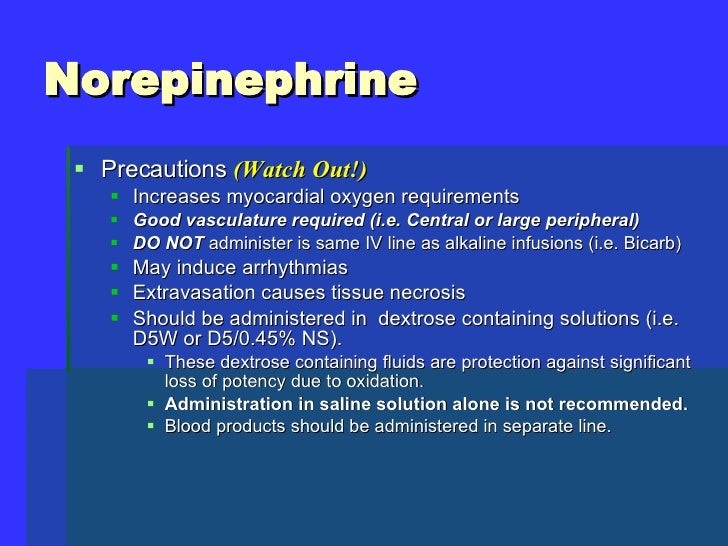

Date of first authorisation/renewal of the authorisation 6.6 Special precautions for disposal and other handling.4.7 Effects on ability to drive and use machines.4.5 Interaction with other medicinal products and other forms of interaction.4.4 Special warnings and precautions for use.4.2 Posology and method of administration.Nursing Made Incredibly Easy! 11(2), 1 – 2.Show table of contents Hide table of contents Nursing Made Incredibly Easy!, 11(1), 25 – 29. Dimensional analysis: Calculate dosages the easy way. Be sure to check back next month!Ĭookson, K.L.
Levophed drip how to#
In the next and final installment of this series, we will review how to calculate drops per minute which is a handy calculation to know when you are not using an IV pump. These calculations can be tricky but get easier with practice. Know general therapeutic drug doses for commonly administered medications.Have a colleague or pharmacist check your work.Check that your answer makes sense clinically.

Step 5: Divide by the weight in kilograms to get mcg/kg/min. This is placed next in the equation.Ĭancel out the labels until you are left with mcg/min. We know there are 60 minutes in one hour. We know our current pump rate is 16 mL/hour. Step 3: Alternate labels in numerator and denominator so labels cancel out. This can now be added to the right side of the equation. Multiply this by 1000 mcg per mL and simplify the fraction to get 3,200 mcg/mL. Before we can do this, we need to convert the concentration from miligrams (mg) to micrograms (mcg). Step 2: Place the same label in numerator. Then we will incorporate the weight (kg) at the end. Step 1: What label is needed? Since we are looking for the dose in micrograms per kilogram per minute (mcg/kg/min) and it is difficult to solve with more than two variables, let’s first solve for mcg/min. The concentration of dopamine is 800 mg/250 mL. You see your patient is on a dopamine drip and the pump rate is 16 mL/hour. In the meantime, you review the continuous drips that are running. Step 4: Multiply numerators, multiply denominators, then divide numerator by denominator.Įxample: You are waiting to receive shift report. If the weight is in pounds, you will need to convert it to kilograms before adding it to the equation.Ĭancel out the labels until you are left with mL/hour. Place this in the equation so that milligram labels will cancel out.Īdd the prescribed dose 10 mcg/kg/min, placing mcg in the numerator so that it will cancel out.Īdd 60 minutes/hour next so that minutes cancel out.įinally, add the patient’s weight in kilograms. We want to get to micrograms and we know 1 milligram (mg) equals 1000 micrograms (mcg). Step 1: What label is needed? We want to know what rate to set the IV pump. What is the hourly IV pump rate? The patient weighs 85 kilograms. The pharmacy provides dopamine 800 mg in 250 mL of D 5W. Intravenous (IV) Drips in mcg/kg/minute Example: Administer dopamine at 10 mcg/kg/min. You can find a handy conversion chart in our Nursing Pocket Card: Common Calculations. Don’t forget, every nurse should be comfortable with basic metric conversions.

We will now take the DA method one step further to calculate weight-based continuous IV drips. We used the DA method to calculate tablet doses, intravenous bolus doses and continuous IV drip rates in units per hours (u/hour) and micrograms per minute (mcg/minute). We’ve reviewed quite a bit of information so far including the Universal Formula and Dimensional Analysis (DA). Welcome back to our drug calculation series. Facing Ethical Challenges with Strength and Compassion.
Levophed drip professional#


 0 kommentar(er)
0 kommentar(er)
